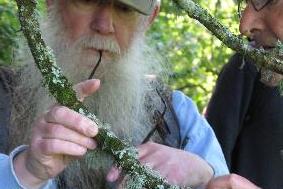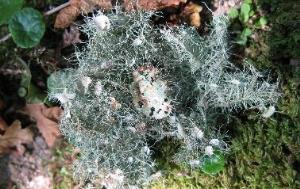 From a lichen’s perspective the Bovey Valley in East
Dartmoor National Nature Reserve is an ideal home. In fact, Hisley Wood is a
Site of Special Scientific Interest recognised for its assemblages of lichen,
but having legal protection is only part of the story. To sustain these
precious and rare species, more information is needed about the local lichen
present in the woods. This is where the Lichen Lovers come in-to champion this miniature
world. The Lichen Lovers are a group of enthusiastic and committed Devon
naturalists who, between them, have a vast knowledge of hundreds of species of
lichen and associated woodland wildlife. Their aim is to map their findings for
Natural England and the Woodland Trust to develop habitat management plans.
From a lichen’s perspective the Bovey Valley in East
Dartmoor National Nature Reserve is an ideal home. In fact, Hisley Wood is a
Site of Special Scientific Interest recognised for its assemblages of lichen,
but having legal protection is only part of the story. To sustain these
precious and rare species, more information is needed about the local lichen
present in the woods. This is where the Lichen Lovers come in-to champion this miniature
world. The Lichen Lovers are a group of enthusiastic and committed Devon
naturalists who, between them, have a vast knowledge of hundreds of species of
lichen and associated woodland wildlife. Their aim is to map their findings for
Natural England and the Woodland Trust to develop habitat management plans.
On a recent October morning two Land Rovers full of experts and trainees set off across the reserve kitted out with the essential equipment; a small magnifying lens and a note pad. Their task for the day was to study the rocks and trees along an ancient boundary high up on Lustleigh Cleave and write a current and accurate species list. Looking closely at the minute detail of woodland biodiversity is the first step in protecting the whole ecosystem and, as they got their heads down to work, this bottom up approach became apparent. The future plans for coppicing shrubs and felling larger trees would be specifically targeted to create the optimum conditions of humidity and sunlight to meet the needs of these interesting and infinitely varied species, some of which are not even visible to the naked eye.
When viewed through a lens this world in miniature comes
alive. There are three basic growth forms of lichen including Crustose (forming
a crust on rocks and trees), Foliose (with leaves of varying shapes and sizes)
and Fruiticose (often with coloured fruit) and the variety of shapes, shades
and sizes is mind boggling.
There are unusual species in these Dartmoor woods and one beard lichen (Usnea florida) is nationally important. It grows in ancient woodland canopies and formerly inhabited much of Devon but is now confined to a few areas of Dartmoor.
So now it is critical to champion the lichens in the Bovey Valley in order to protect and enhance the growing conditions for these key parts of the local wild diversity. Not only is lichen an important link in the food chain but its structure is an interesting amalgamation of both fungus and algae. Each lichen comprises both types of organism and, to reproduce, must have the perfect site and conditions for both to survive and spread. This precarious life cycle is made even more perilous by competition between species, where each species fights for space with all the others around it. A close inspection of a small area of oak bark will reveal numerous patches of different colours and textures in close combat with each other. This woodland becomes all the more important the deeper you look into it.
Though many of us know that lichen growth can be a sign of good air quality this detailed work is crucial for a healthy environment in the long term. The members of the Devon Lichen Group provide much of the expertise for the survey and citizen science like this is part of a sustainable process and will identify the current hotspots where careful management can create conditions for lichen to thrive long after the study is over.-
Written by Matt Parkins
Last update: 03 Nov 2015 5:02pm

